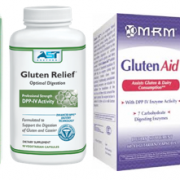What is Kombucha and What’s in It for the Gluten Free?
Going gluten free can be the gateway for trying food from other cultures – or trying cultures that are food!
Case in Point – Kombucha!
Kombucha refers to any of a variety of fermented, lightly effervescent sweetened black or green tea drinks that are commonly used as functional beverages for their unsubstantiated health benefits. Kombucha is produced by fermenting tea using a “Symbiotic ‘COlony’ of Bacteria and Yeast” (SCOBY). Actual contributing microbial populations in SCOBY cultures vary, but the yeast component generally includes Saccharomyces and other species, and the bacterial component almost always includes Gluconacetobacter xylinus to oxidize yeast-produced alcohols to acetic and other acids.
Beverages referred to as kombucha originated around 5,000 years ago in China, though the English word can only be traced to 1991 and is of uncertain etymology. Historically, kombucha has been home-brewed or locally brewed; in the late 1990s, commercially bottled kombucha became available in North American retail stores. It is known in Chinese as chájūn (茶菌), Japanese as kōcha-kinoko (紅茶キノコ), Korean as hongchabeoseotcha (홍차버섯차) and Russian as chaynyy grib (чайный гриб).
Kombucha has been claimed to cure many diseases and to have a wide range of health benefits; however, there is a lack of high-quality evidence to support these claims. There are several documented cases of adverse effects related to kombucha drinking, and there is the potential for contamination during home preparation. A systematic review found that the mostly unclear benefits of kombucha drinking did not outweigh the known risks, thus should not be recommended for therapeutic use. Source: https://en.wikipedia.org/wiki/Kombucha
What is SCOBY?
One of the bacteria included in kombuchas is Saccharomyces boulardii, a tropical strain of yeast first isolated from lychee and mangosteen fruit in 1923 by French scientist Henri Boulard. It is related to, but distinct from, Saccharomyces cerevisiae in several taxonomic, metabolic, and genetic properties.[1] S. boulardii is sometimes used as a probiotic with the purpose of introducing beneficial active cultures into the large and small intestine, as well as conferring protection against pathogenic microorganisms in the host.[2][3][4] However, in immunocompromised individuals, S. boulardii has been associated with (fungemia) or localized infection, which may be fatal.
Boulard first isolated this yeast after he observed natives of Southeast Asia chewing on the skin of lychee and mangosteen in an attempt to control the symptoms of cholera. In healthy patients, S. boulardii has been shown to be non-pathogenic, non-systemic (it remains in the gastrointestinal tract rather than spreading elsewhere in the body). It grows at the unusually high temperature of 37 °C (98.6 °F). Source: https://en.wikipedia.org/wiki/Saccharomyces_boulardii
Why do the gluten free need probiotics?
The composition of gut microbiota is crucial for human health. Normal gut microbiota enhances digestive processes, produces certain vitamins and nutrients, facilitates absorptive processes, participates in development and maturation of the immune system and limits colonization of the gut by pathogenic microorganisms. Abnormalities in the composition of normal gut microbiota, also known as dysbiosis, frequently result in the development of chronic inflammatory, autoimmune and atopic processes not only within the gut but also in the distant body compartments such as skin, exocrine glands, the brain, muscles and joints. It is well recognized that people affected by poorly controlled celiac disease have detectable dysbiosis. Source: https://www.celiac.com/articles/23617/1/Role-of-Probiotics-in-Improving-Gut-Health-in-Celiac-Disease/Page1.html
What are digestive enzymes and why are they so important?
We eat food, but our digestive system doesn’t absorb food, it absorbs nutrients. Food has to be broken down from things like steak and broccoli into its nutrient pieces: amino acids (from proteins), fatty acids and cholesterol (from fats), and simple sugars (from carbohydrates), as well as vitamins, minerals, and a variety of other plant and animal compounds. Digestive enzymes, primarily produced* in the pancreas and small intestine, break down our food into nutrients so that our bodies can absorb them. Source: https://whole9life.com/2012/09/digestive-enzymes-101/
Why might the gluten free require vitamin supplementation?
There are a variety of nutritional deficiencies associated with celiac disease, primarily caused by the inability of the damaged small intestine to properly absorb enough of the nutrients our bodies need. People recently diagnosed with celiac disease are commonly deficient in fiber, iron, calcium, magnesium, zinc, folate, niacin, riboflavin, vitamin B12, and vitamin D, as well as in calories and protein. Deficiencies in copper and vitamin B6 are also possible, but less common. A study from 2002 by Bona et. al. indicated that the delay in puberty in children with celiac disease may partially be due to low amounts of B vitamins, iron, and folate. Source: https://celiac.org/live-gluten-free/glutenfreediet/vitamins-and-supplements/#tdzF8QicxXkIGZXo.99
Where to dine and shop gluten free on Vancouver Island
Victoria • Blanshard • Cook-Fairfield • Douglas Street • Fernwood • Fort Street • Government Street • Hillside • Inner Harbour • James Bay • Oak Bay • Quadra • Royal Oak – Broadmead • UVic Or NEARBY in • Brentwood Bay • Colwood • Esquimalt • Langford • Metchosin • Sidney • View Royal On VANCOUVER ISLAND • Campbell River • Chemainus • Cobble Hill • Comox • Coombs • Courtenay • Cowichan Bay • Duncan • Ladysmith • Lake Cowichan • Mill Bay • Nanaimo • Nanoose Bay• Parksville• Qualicum Beach• Port Renfrew• Shawnigan Lake• Sooke • Tofino • Ucluelet On the GULF ISLANDS • Cortes Island • Gabriola Island • Hornby Island • Salt Spring Island













